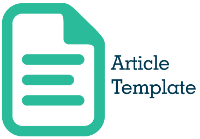The CHAIN WRITING METHOD IN LEARNING WRITING FOR INFORMATION TECHNOLOGY FACULTY STUDENTS: The Effectiveness
DOI:
https://doi.org/10.35457/jares.v6i2.1631Keywords:
chain writing, descriptive text, experimental study.Abstract
This study purposes in determining the effectiveness of students writing ability on descriptive text being taught using the Chain Writing Method for the B class of Informatics Engineering Study Program Balitar Islamic University 2020/2021 academic year. This research is an experimental research, which uses the chain writing method to find out its effectiveness from student learning outcomes. The population of this study were first semester students of Informatics Engineering Study program which consisted of 21 students as a sample. The researchers applied one group pretest posttest. The sampling technique is random sampling. The method used is a quasi-experimental design. The pretest result done by Informatics Engineering students shown the average was 44.19%. The pre-test was conducted by researcher in March 2020. Then it can be concluded that their Writing Descriptive text ability are not good enough. The results of data analysis, known that the chain writing method is more effectively used in learning to write descriptive text for B class of Informatics Engineering students. It has significance difference in mean of determining by précising statistics of dependent T-test. From the calculating result of the t-test found that the t-value obtained was 5,959, while the required critical t-value at p> .05, the level of significance of the two tailed test is 2.086 (df = 20), p> .01 the two tailed significant level of test was 2.845 (df = 20). The data results of this research indicates that there is a significance difference in pretest and posttest score result. This proves that the chain writing method is effective method in learning the descriptive texts for the informatics engineering class in the 2020/2021 academic year.
Downloads
References
Arikunto, S. (2010). Prosedur Penelitian Suatu Pendekatan Praktik, Jakarta: Rineka Cipta, Cet. Ke-13.
Attle, S., & Baker, B. (2007). Cooperative learning in a competitive environment: Classroom applications. International Journal of Teaching & Learning in Higher Education, 19(1). https://www.isetl.org/ijtlhe/pdf/ijtlhe121.pdf
Dewi, U. (2013). How to write. http://repository.uinsu.ac.id/8566/
Gebhard, J. G. (2006). Teaching English as a foreign or second language: A teacher self-development and methodology guide. University of Michigan Press. https://books.google.co.id/books?hl=id&lr=&id=HBUgNRvBVFQC&oi=fnd&pg=PR7&dq=Gebhard,+J.+G.+2000.+Teaching+English+as+a+Foreign+or+Second+Language:++A%09Teacher+Self-Development+and+Methodology+Guide.+Ann+Arbor:+The+University+of+Michigan+Press.&ots=hiqQkpqeP3&sig=tMugxOwYUfA6ZUwLe7BXWSt_Zps&redir_esc=y#v=onepage&q&f=false
Halliday, M. A. K., & Martin, J. R. (2003). Writing science: Literacy and discursive power. Taylor & Francis. https://books.google.co.id/books?hl=id&lr=&id=ZDB6AgAAQBAJ&oi=fnd&pg=PP1&dq=Ak+Prize+2003+Writing+is+a+process,+namely+the+process+of+writing,+the+process+of+reasoning&ots=iTnxcoo88u&sig=WJ6teMb_B6GbD-aHt-1tgQfqxVQ&redir_esc=y#v=onepage&q&f=false
Kane, T. S. (2000). Oxford essential guide to writing. http://lib.bvu.edu.vn/handle/TVDHBRVT/3731
Kerr, B., Condon, S. M., & McDonald, L. A. (1985). Cognitive spatial processing and the regulation of posture. Journal of Experimental Psychology: Human Perception and Performance, 11(5), 617. https://doi.org/https://psycnet.apa.org/doi/10.1037/0096-1523.11.5.617
Mackenzie, N., & Veresov, N. (2013). How drawing can support writing acquisition: Text construction in early writing from a Vygotskian perspective. Australasian Journal of Early Childhood, 38(4), 22–29. https://doi.org/https://doi.org/10.1177%2F183693911303800404
Mendale, B. P., Komariah, E., & Fitriani, S. S. (2019). Analyzing Students’ Ability in Using the Language Features in Writing Descriptive text. Research in English and Education Journal, 4(4), 183–189. http://www.jim.unsyiah.ac.id/READ/article/view/14128
Newmann, F. M. (1986). Priorities for the future: Toward a common agenda. Social Education, 50(4), 240–250. https://eric.ed.gov/?id=EJ335096
Nystrand, M. (1989). A social-interactive model of writing. Written Communication, 6(1), 66–85. https://doi.org/https://doi.org/10.1177%2F0741088389006001005
Oakes, J., & Lipton, M. (1990). Tracking and ability grouping: A structural barrier to access and achievement. College Entrance Examination Board. https://psycnet.apa.org/record/1990-98101-008
Pardiyono, M. P. (2006). Sure. English for Writing Acquisition. Surakarta: LPID UMS.
Purba, R. (2018). Improving the achievement on writing narrative text through discussion starter story technique. Advances in Language and Literary Studies, 9(1), 27–30. https://doi.org/http://dx.doi.org/10.7575/aiac.alls.v.9n.1p.27
Ritonga, S. (2019). The Effect of Inquiry Method on Student’s Ability in Writing Exposition Text at the Eleventh Grade Students of MAN Labuhanbatu. Red: Revolution of English Department Journal, 3(1). https://ejurnal.univalabuhanbatu.ac.id/index.php/red/article/view/263
Samad, I. A., Fitriani, S. S., Rahma, E. A., Sofia, S. S., & Rizkanisa, N. (2020). ACADEMIC WRITING FOR UNIVERSITY STUDENTS. Jakad Media Publishing.
Sari, A. M., Rasyid, Y., & Muliastuti, L. (2018). Development of exposition text writing materials based on contextual approach. Jurnal Pendidikan Dan Pengajaran, 51(3), 122–131. https://doi.org/http://dx.doi.org/10.23887/jpp.v51i3.15924
Sari, T. D. (2018). The Implementation Of Chain Writing Method To Increase Students Ability Writing Narrative Text At Mts. Al-Muttaqin Padang Tualang Langkat. Universitas Islam Negeri Sumatea Utara Medan. http://repository.uinsu.ac.id/4159/
Suparno, M. Y. (2008). Keterampilan dasar menulis. Jakarta: Universitas Terbuka.
Wolff, M., Wagner, M. J., Poznanski, S., Schiller, J., & Santen, S. (2015). Not another boring lecture: engaging learners with active learning techniques. The Journal of Emergency Medicine, 48(1), 85–93. https://doi.org/https://doi.org/10.1016/j.jemermed.2014.09.010
Downloads
Published
Issue
Section
License
Authors who publish with this journal agree to the following terms:
- Copyright on any article is retained by the author(s).
- Author grant the journal, right of first publication with the work simultaneously licensed under a Creative Commons Attribution License that allows others to share the work with an acknowledgement of the work’s authorship and initial publication in this journal.
- Authors are able to enter into separate, additional contractual arrangements for the non-exclusive distribution of the journal’s published version of the work (e.g., post it to an institutional repository or publish it in a book), with an acknowledgement of its initial publication in this journal.
- Authors are permitted and encouraged to post their work online (e.g., in institutional repositories or on their website) prior to and during the submission process, as it can lead to productive exchanges, as well as earlier and greater citation of published work.
- The article and any associated published material is distributed under the Creative Commons Attribution-ShareAlike 4.0 International License














